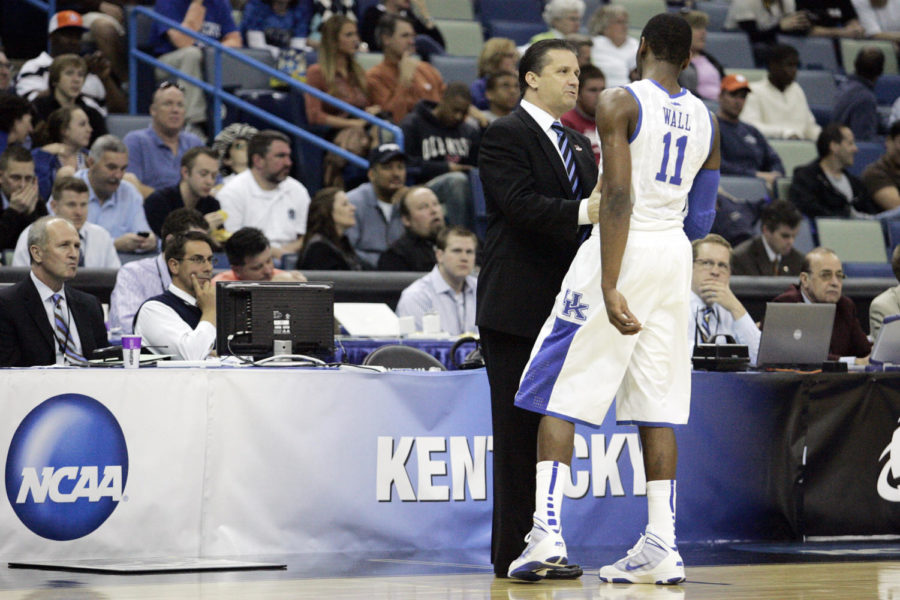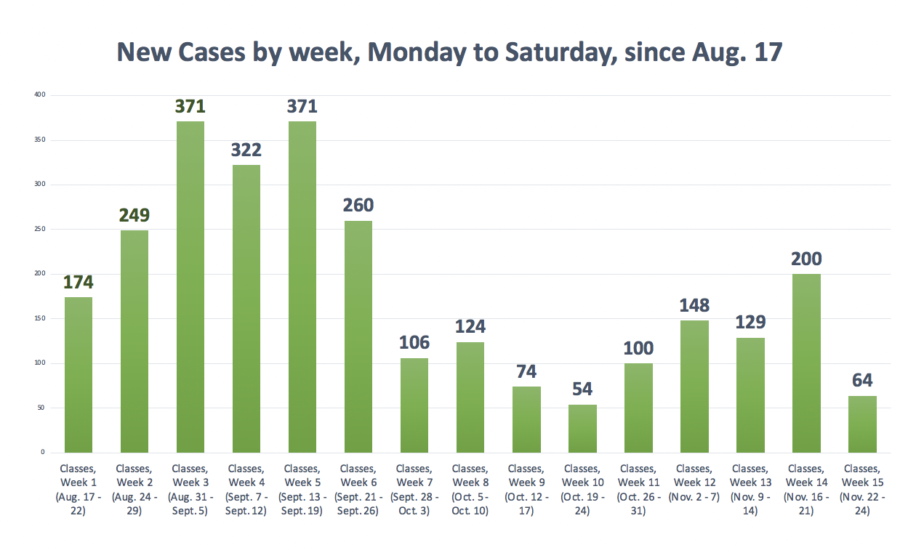How COVID-19 cases among UK students stack up at the end of the semester
November 30, 2020
Early in this reopened fall semester, the UK administration repeatedly refused to commit to a case threshold that would shut down the university. Now, at the tail end of November, that threshold was apparently never reached – UK maintained an in-person, on-campus presence until the designated end date, Nov. 24, despite at least 2,746 recorded cases of COVID-19 among UK students.
2,746 cases arise from the combined data of UK’s COVID-19 dashboard and the Lexington-Fayette County Health Department’s daily updates of COVID-19 cases.
Until early November, LFCHD was reporting college cases on a school-by-school basis, meaning that UK student cases were reported as a reliable, distinct figure. But, because of surging COVID-19 cases and a switch to the state’s reporting system, LFCHD was no longer able to track distinctly UK cases. On the last daily update with school-by-school reporting, LFCHD showed a total of 2,627 cases among UK students; according to LFCHD spokesperson Kevin Hall, 231 of those cases occurred prior to Aug. 17, the beginning of the fall semester.
Since then, UK has reported 350 cases of COVID-19 on its dashboard. Combined with the 2,396 semester cases from LFCHD, this amounts to 2,746 cases of COVID-19 among UK students during the semester.
UK’s dashboard, which goes back to July 20, reports a total of 3,107 cases among UK students, 287 of which were active as of Nov. 24. UK’s total number of cases among students is higher than the health department’s, not because there are more cases, but because UK was able to track cases belonging to the student demographic through the end of the semester, unlike LFCHD, and reported cases among students who were not Lexington residents, which LFCHD did not begin to do until over a month into the semester.
According to the dashboard, UK conducted nearly 49,098 tests and received 2,378 positives, leading to a semester positivity rate of 4.8 percent – just below the 5 percent threshold that the World Health organization recommends an area can loosen or tighten restrictions, depending on the direction of the trend.
Most of the cases happened in the first half of the semester; weekly cases peaked at 371 for the week of Sept. 13 – Sept. 19, two weeks after Labor Day and Derby Day caused a rash of student gatherings.
The spike in the second half of the semester occurred, as predicted, two weeks after Halloween with 200 cases in the week of Nov. 16 – Nov. 21.
Weekly cases were at their semester low during midterms in October. The rate of infection slowed as the semester progressed; it took 23 days to hit the first 1,000 cases, another 31 days to hit 2,000 and 42 days after that benchmark uK has yet to definitively hit 3,000 student cases.
Daily cases peaked at a single-day high of 106 on Sept. 14 and rarely topped 40 in the second half of the semester.
Comparatively, UK students are responsible for disproportionately more college cases than respective college size would suggest. On the last day of reporting cases by college, LFCHD reported a total of 2,938 cases among college students – 2,627 of which came from UK students. UK students thus accounted for 89 percent of the 2,938 cases of COVID-19 among Lexington college students recorded by the health department as of Nov. 9.
UK is by far the largest university in Lexington with a total student population of about 30,000, though according to the dashboard only 23,982 were physically coming to campus this semester. The actual number of UK students in Lexington might be larger – some students, especially those from Lexington or those already committed to jobs or leases, may have chosen to live in town despite having all online courses.
It is unknown how many students from other colleges in Lexington were physically coming to campus, but using low-end numbers for the student populations of the other three colleges tracked by LFCHD, the total college student population is just under 40,000. Thus, UK students only account for 75 percent of the college student population in Lexington, but account for 89 percent of college cases – a gap of about 14 percent.
UK students also account for a disproportionate number of cases in Lexington compared to their share of the population. This was true throughout the semester; on any given day, the number of new student cases accounted for an average of 20 percent of the city’s new cases (daily share of cases ranged from 5 percent to, on Sept. 8, 71 percent).
On Nov. 9, LFCHD had reported a total of 12,468 cases among Lexington-Fayette County residents since March. That same day, LFCHD reported a total of 2,627 cases among UK students – or 21 percent of the city’s total cases.
The best, most accurate number of total cases among UK students is 2,977, which combines the 231 cases reported by LFCHD prior to the beginning of the semester with the 2,746 that have been recorded since then. The 3,107 cases reported by UK are less clear in their origin and time frame. As of Nov. 27, LFCHD has reported 16,683 total cases of COVID-19 in Lexington. Cases among UK students thus account for at least 17.8 percent of cases in Lexington.
Depending on the metric, UK students account for 8 or 9 percent of Lexington’s population.
According to the U.S. census, Lexington has a population of 323,152. Whether or not college students are included in that number is unclear – the census recommends that students list their usual address as their city of primary residence, which for most college students would be the city of their university. However, the degree to which that recommendation is followed and the number of college students who actually fill out the census are both unknown.
If college students are included in the census data for Lexington, then UK students (undergraduate and graduate) equal 9 percent of the population, a disproportion of 8.8 percent in terms of COVID-19 cases.
If college students are not included in the census data for Lexington, then the population is bumped up about 40,000 to 363,152. UK students, at 30,000, would then equal 8 percent of the city’s population, a disproportion of 9.8 percent in terms of COVID-19 cases.
Using the number of students UK says is coming to campus – 23,982 – results in UK students amounting to 6 or 7 percent of Lexington’s population, depending on census method.
In summary, the number of cases among UK students is at least double its share of the population.
The share of UK students who have had COVID-19 is far less, comparatively. UK’s dashboard number of 3,107 is better to use for this figure, even though it goes back to July, because the total number of students who had it is more important than when they had it.
With a student population of 30,000, this means that at the end of the fall semester in 2020 at least 10 percent of UK students have had coronavirus. 10 percent is a far cry from the percentage needed to reach hypothetical herd immunity.
However, the actual percentage of UK students who have had COVID-19 and thus may have some immunity may be greater than 3,107. UK recorded cases among students in Lexington, and only going back to July 20. The health department recorded cases since March, but at first only students who are permanent Lexington residents.
Combined, those approaches mean that any student who is not a Lexington resident and contracted COVID-19 between March and the end of July is not included in available statistics; neither are students who have contracted it this semester while living outside of Lexington. Those student cases would instead be reflected in their local health department’s numbers, whether they are from out-of-state of somewhere else in Kentucky. With over 3 and a half million cases of COVID-19 in the missing summer months, the odds that more UK students have had COVID are high.
Students may also test positive for COVID-19 over winter break, which would not be included in UK’s numbers. UK ceased reporting COVID-19 cases on Nov. 27, ending their semester tracking with the Nov. 24 update. According to the dashboard, 18 students were in campus isolation facilities as of Nov. 24 – UK kept the quarantine dorm open past the end of the semester for students. In the spring semester, UK will again take steps to test students for COVID-19 upon their return to campus.






























































































































































